Identification and Treatment of Pests in Trees and Shrubs
Tent Caterpillars
Symptom: Silken tent on the end of branches visible
Time: End of June to the end of August
Damage: Complete defoliation of a branch. The silken tent looks unsightly.
Treatment: Prune and destroy all affected branches. If spraying with Insecticide, make sure to spray in the LATE evening when the Caterpillars are out of the nest, otherwise, the Insecticide will never reach them.
Plants Affected: Locust, Hawthorn, Apples and many other Shade trees.
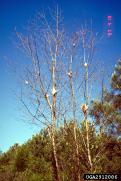
Eastern Tent
Caterpillar
The Bugwood Network
& Forestry Images
Army Worm
Symptom: Worms feeding together in groups on your plants.
Time: May
Damage: Partial defoliation
Treatment: Birds are a very good control for the Army Worm.

Army Worm
Center for Urban Ecology
& Sustainability at the
University of Minnesota
Black Vine Weevil
Symptom: Needles of Yews have moon-shaped holes cut out of their edges
Time: Spring or summer
Damage: None, except a little yellowing
Treatment: Parasitic Nematodes (can be sprayed on when watering)
Plants Affected: Yews
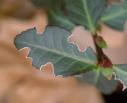
Bag Worm
Symptom: Brown, shaggy bags (1.5-2.5”) hanging from branches.
Time: Late Summer
Damage: Partial defoliation
Treatment: Pick off the bag by hand. If spraying Insecticide, do it in the late afternoon when insects are feeding.
Plants Affected: Evergreens and Woody Ornamentals

Bag Worm
Department of Entomology
at Purdue University
Canker Worm
Symptom: Large sections of young leaves eaten away, leaving only the midribs & veins.
Time: Noticeable in early May.
Damage: While unsightly, no permanent damage occurs
Treatment: Parasitic wasps will normally keep populations down. Also, use a General-purpose Insecticide.
Plants Affected: Apples, Oaks, Lindens and Beeches
Picture Unavailable
Cut Worm
Symptom: These little fellows eat off your newly transplanted plant at ground level, leaving the top of the plant lying there on the ground.
Time: Early spring (beginning of June)
Damage: Plant death
Treatment: General-purpose Insecticide. Cultivate the soil in the fall to expose the larva at the top of the soil to allow birds to eat them.
Plants Affected: Mostly newly planted annuals

Cut Worm
Center for Urban Ecology
& Sustainability at the
University of Minnesota
Flat Head Borer
Symptom: Sawdust at base of tree with sap running from holes in the tree
Time: Late spring
Damage: Tree death if they bore tunnels in the bark all around the tree, thus cutting off nutrient transport from the roots to the rest of the tree.
Treatment: Maintain vigor in the trees to encourage healthy growth (good fertilization, moisture control, etc.); avoid mechanical damage from things such as string trimmers or mowers. Determine the direction of the borer’s tunnel by sticking a wire in it, then cut out the damaged area of the bark with a knife. Cut it out early before girdling occurs.
Plants Affected: Many shade trees
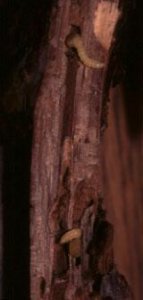
Gypsy Moth
Symptom: Large section of the tree or shrub stripped bare
Time: Summer
Damage: Defoliation. If this happens three years in a row, plant death
occurs.
Treatment: Biological control such as Pheromone traps or beneficial insect (nematodes) may help, although there is no really good control for these. Effective Insecticide: Sevin.
Plants Affected: Shade trees and Ornamental shrubs
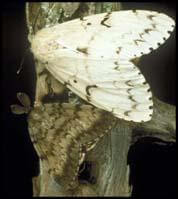
Gypsy Moth
Iris Borer
Symptom: Rotting of Iris Roots observable from the surface, as the roots lie right on ground). Yellowing and death of leaves
Time: Late summer
Damage: Plant death
Treatment: Dig up and destroy infected rhizomes (roots). When you plant new ones, dust the root areas with sulfur. Don’t mulch over rhizome (bulb), and don’t let a bunch of leaves and grasses grow around it will also control Aphid Populations.
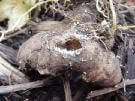
Iris Borer Damage
Purdue Extension
Japanese Beetle
Symptom: Surface of leaves completely eaten away, leaving only a netted appearance.
Time: June
Damage: Defoliation. No permanent damage.
Treatment: Biological or systematic spraying during the infestation period.
Plants Affected: Roses and Lindens among many other Ornamentals and Trees

Japanese Beetle
Center for Urban Ecology
& Sustainability at the
University of Minnesota
May or June Beetle
Symptom: White grubs in flower or shrub beds
Time: Early spring or late fall
Damage: Defoliation, although not as bad as that caused by Japanese Beetles. The damage done to the roots by the grubs is much greater than that done by the beetle itself.
Treatment: Biological or systematic spraying during the infestation period.
Plants Affected: Water with Biologicals or Insecticides to control grubs.

June Beetle
Center for Urban Ecology
& Sustainability at the
University of Minnesota
Lace Bugs
Symptom: Specked yellow blotches on leaves
Time: Mid-spring to early summer
Damage: Unsightly, but no real damage
Treatment: Maintain the vigor of the plant. If infestation is heavy, spray with generic Insecticide in mid-May.
Plants Affected: Azaleas, Rhododendrons and many other Ornamental Shrubs and Trees
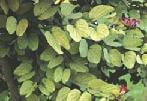
Symptom of Lace Bug
University of Florida,
Institute of Food &
Agricultural Sciences
Extension
Leaf Miners
Symptom: Like the Flat Head Borer in bark, the Leaf Miner tunnels between the upper and lower surfaces of a leaf. The outline of their tunnels is visible on the leaf.
Time: Spring and summer
Damage: Unsightly
Treatment: Biologicals and systemic Insecticides
Plants Affected: Birch and many Perennials
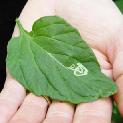
Leaf Miner
Dr. Richard G. Snyder,
Professor & Vegetable
Specialist
Mississippi State
University Truck
Crops Experiment
Station
Mites (Spidermites)
Symptom: Mottled yellow webs visible in the early morning.
Time: Springtime, when temperatures rise above freezing, until the fall frost.
Damage: If severe enough, plant death
Treatment: Dormant oils and Sulfur Plants
Affected: Many Shrubs and Evergreens
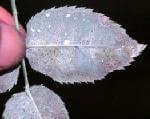
Spidermite damage
Baldo Villegas
Scale Insects
Symptom: Visible on stems and leaves
Time: Hatched in early spring
Damage: Kills plants by sucking the nutrients out.
Treatment: Easiest to control by spraying dormant oil before leaves appear (either late winter or early spring)
Plants Affected: Euonymus, Dogwoods and many others

Symptom of Scale
Insects
Baldo Villegas
Slugs & Snails
Symptom: Large holes eaten in leaves
Damage: Unsightly
Treatment: Slug bate or beer traps
Plants Affected: Hostas and many tender perennials
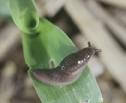
Slug
Copyright © 2005
Purdue University
Spittle Bug
Symptom: Appearance of spit-like bubbles on leaves and stems.
Time: Anytime in the summer
Damage: Unsightly, but no real damage occurs
Treatment: Beneficial Insects or Generalpurpose Insecticides.
Plants Affected: Many Perennials and Flowering Shrubs. The Bean Family.
picture unavailable
European Saw Fly
Symptom: Sections of the plant will seem to suddenly move (2-3,000 worms have been seen on one plant, and they are startled by your movements, thus the “moving bush”). Branches will be completely stripped
Time: Usually in the second week of May.
Damage: Complete defoliation of an entire bush can happen in less than two days!
Treatment: General-purpose Insecticide
Plants Affected: Evergreens, especially the Mugho Pine

European Saw Fly
Penn State Extension
Thrips
Symptom: Flowers turn yellow and then turn brown where petals join the stem.
Time: Anytime the flowers are blooming
Damage: No damage occurs to the plant, but the flowers lose their
beauty
Treatment: General-purpose Insecticide; natural predators such as Lace Wings will also control Thrip populations.

Western Flower Thrip
Dr. Ken MacDonald
Aphids
Symptom: Insects visible on soft tissue and stems or on the underside of leaves. Ne`w growth will curl.
Time: Anytime throughout the growing season (early spring, late summer).
Damage: Unsightly, but no real damage
Treatment: Spray in dormant season with oil. Most mild Insecticides will
control Aphids. Predator insects, such as Lady Bugs and Lace Wings will also control Aphid Populations.
Plants Affected: Most
picture unavailable